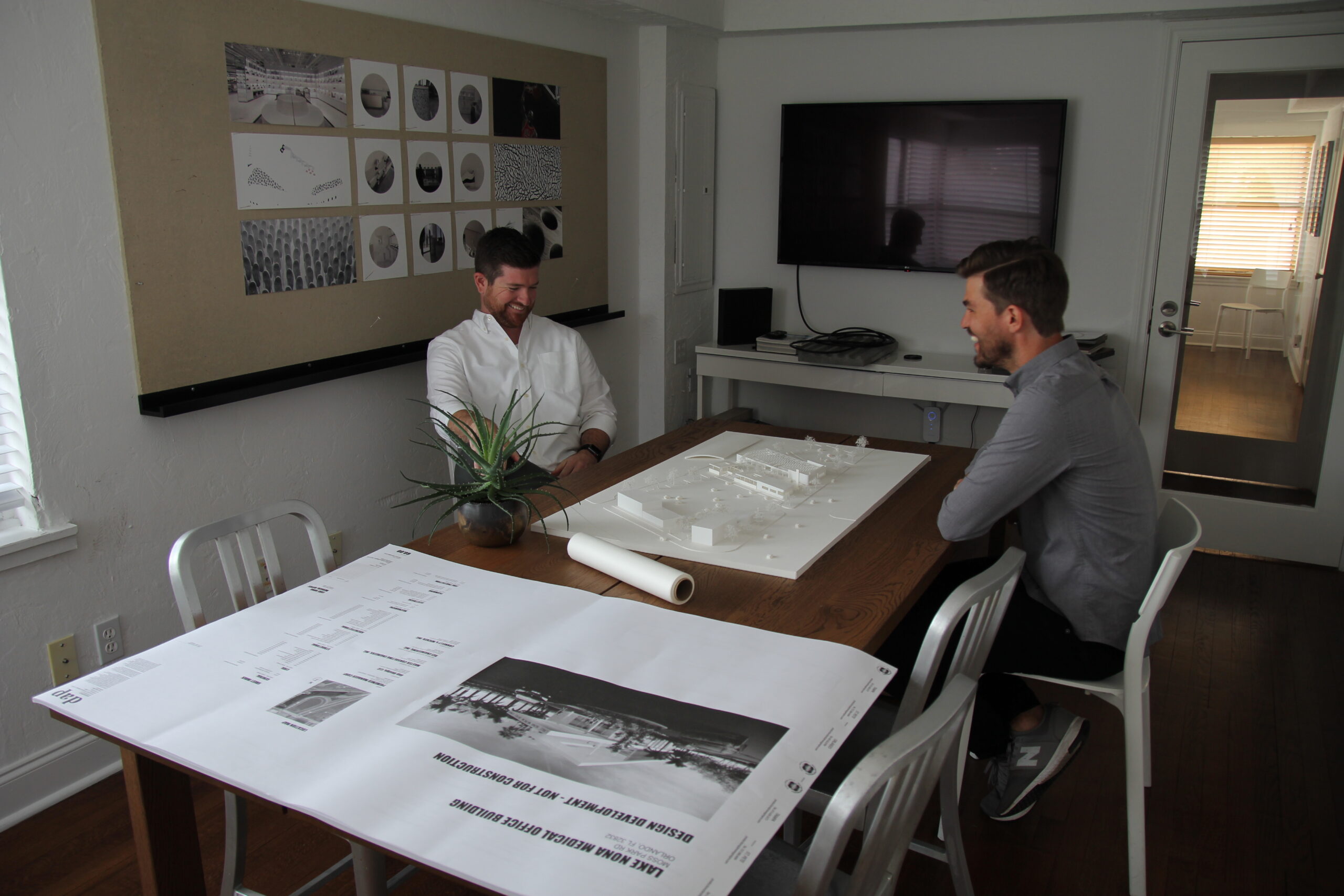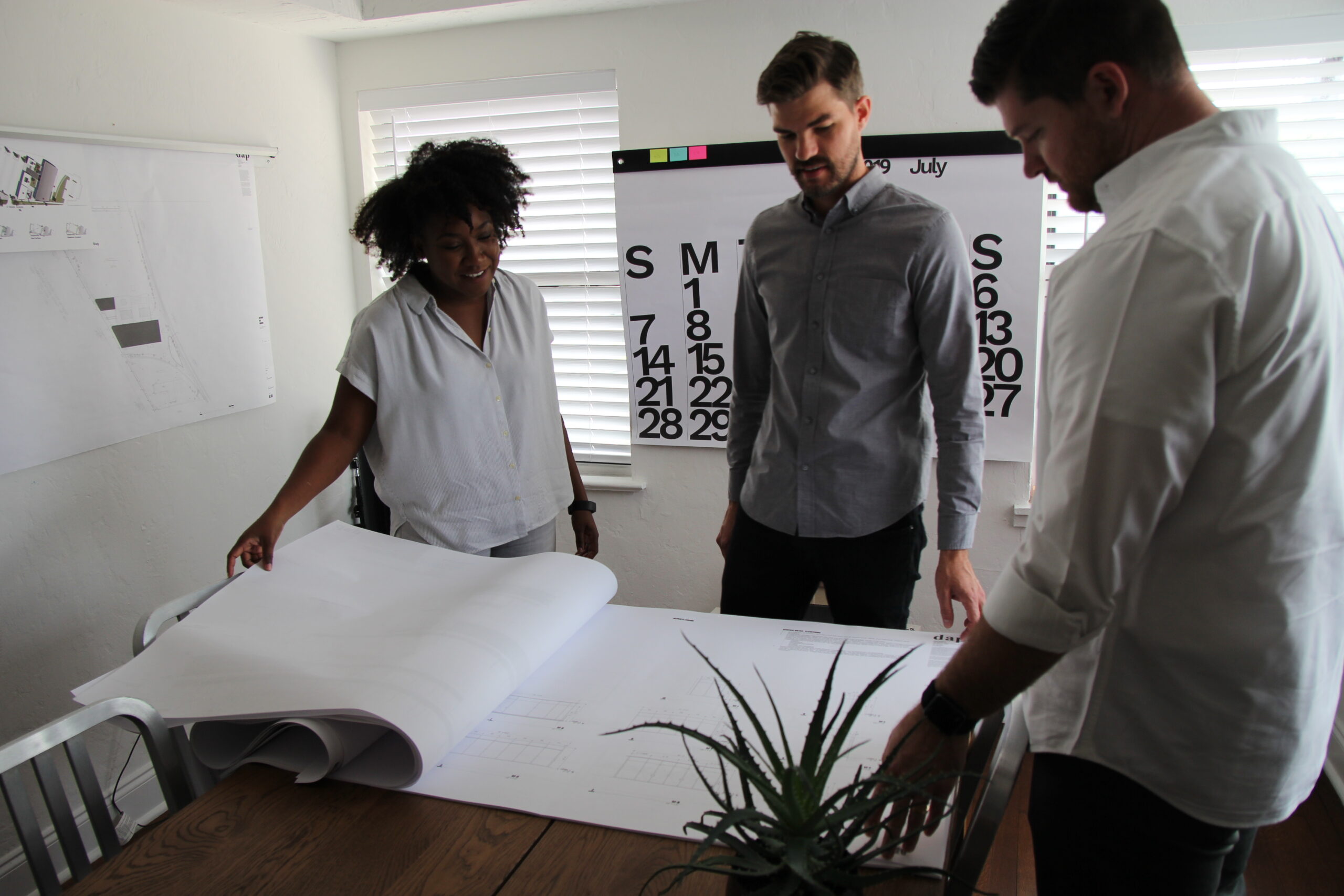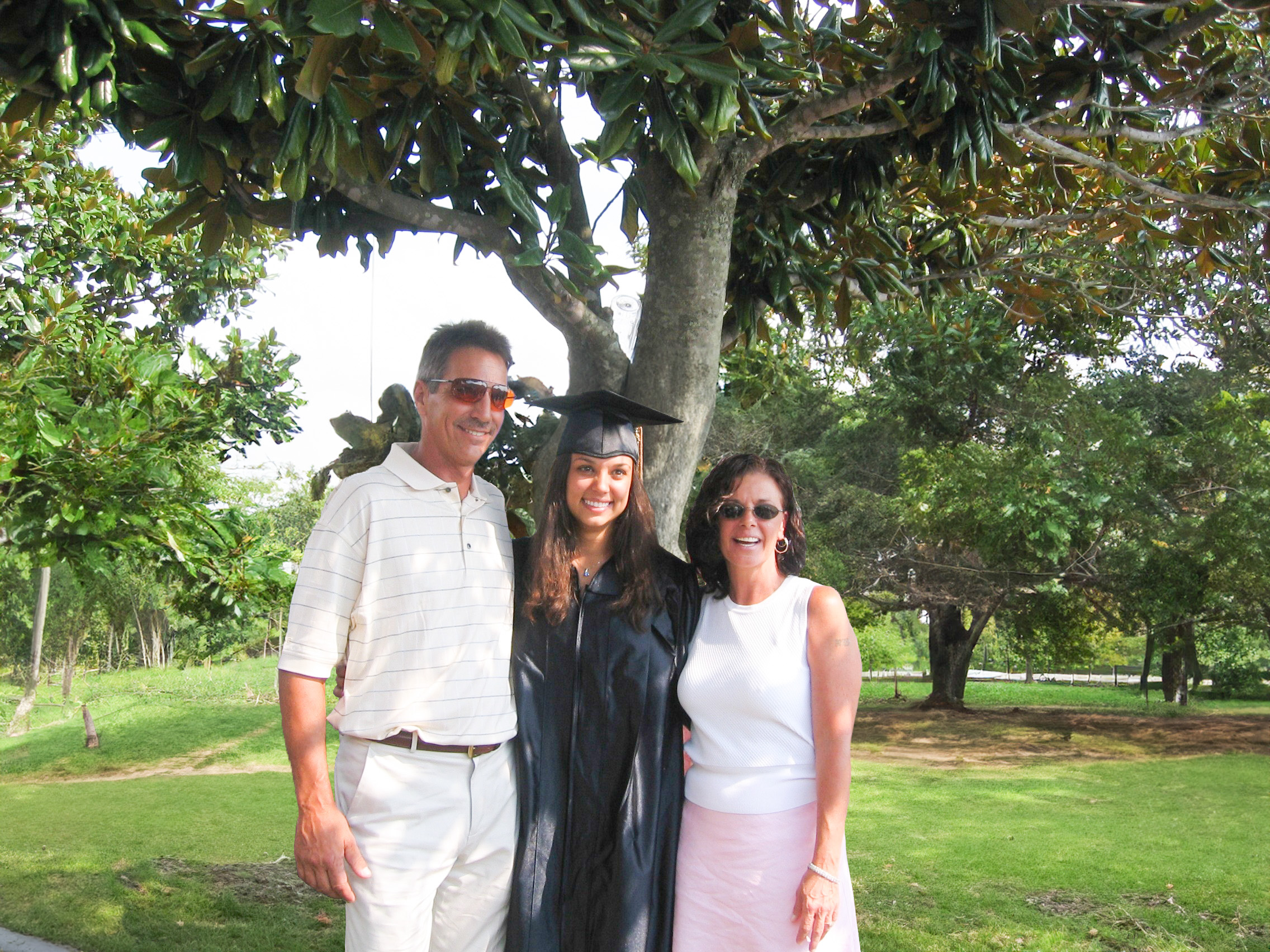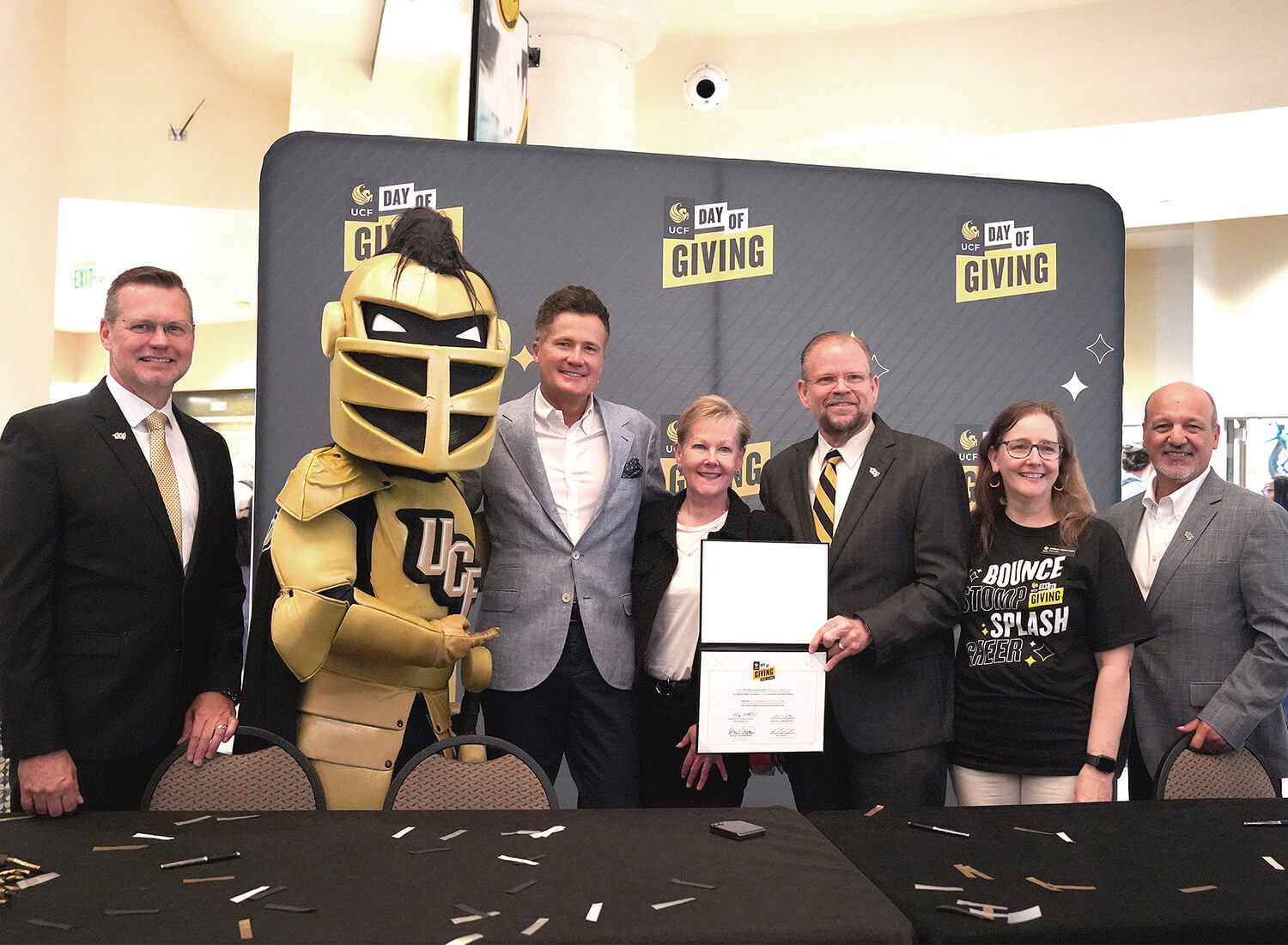From the Ground Up: UCF Architects Pioneer Program and Business

Story and photos by Katie Schmidt
Joel Setzer ’12 was an aspiring drummer with little to no interest in ever attending college.
Jameson Deighan ’12 grew up in a family of artists and had opted early on to pursue sports instead.
Now, the two are not only two-thirds of the founding team at dap, a local design-driven architecture practice, but both Joel and Jameson are graduates of the first class of architecture students in UCF’s College of Arts and Humanities.
I went to visit Joel and Jameson in their (really rad) studio in the Ivanhoe area of town to talk about how the business came to be, what sets it apart, how their UCF experience was and did they or did they not play with Legos as children.
(You’ll notice Joel doesn’t talk much at first and then all of a sudden he does. That’s because he was running a little late at a client meeting and Jameson said we could start without him. Hopefully Joel was cool with that, because it’s what happened and now here it is for everyone to know.)
KATIE: So would I call you one of the founders? Or…?
JAMESON: Partners, founders, part-owners. Joel, Nicole and I started dap in October of 2018, but before that we all worked for a company called Process. Then the guy who ran it got an offer out in California, so the three of us were like, ‘we’re either gonna have to go back to big firms, or start our own thing.’ And then we started our own thing. We kind of see ourselves as a niche in Orlando because we are very design focused with an interest in detail. With architecture, there’s the poetic and pragmatic. You need both of them to complete a project, but we’re heavy on the poetic side.
KATIE: Was that something you guys had talked about before starting dap or you just sunk into it?
JAMESON: All three of us have a conceptual, poetic background from our schooling. When we had worked at bigger firms, before Process and dap, we were like, ‘OK this isn’t what we went to school for.’ The poetic side is what drew us together. I mean Joel and I met in undergrad at UCF and have been friends since, but once we started working together we kinda knew one day we’d want to start our own thing.
KATIE: How’d you get into architecture?
JAMESON: I had always played sports and wasn’t really interested in art, even though my family were all really artistic. After high school I started working at a glass studio. I didn’t even really know what an architect was, but we’d work with a lot of them. I’d see the conversations they would have and it was always problem-solving and talking about design intent. That piqued my interest.
(Joel enters. Pleasantries are exchanged.)
KATIE: We were talking about how Jameson got into architecture. How did you?
JOEL: We always joke about this because so many people put in their professional bios something like, ‘when I was a young boy I liked to play with Legos’ and just — why would a client want to think of you as a young boy? And what young boy didn’t play with Legos?
KATIE: So you did play with Legos?
JOEL: I played with this thing called Consructs. They were like Legos. But, yeah, I played with Legos too. I played music when I was in high school and that’s all I wanted to do until I was about 25 and realized I didn’t want to be a musician forever and started thinking about what path I could take. I think I chose architecture because it’s creative, too. That experience of collaborating with people and writing songs transferred over to how you structure something and the process behind architecture.
KATIE: From your perspective, how did dap come to be?
JOEL: Well Jameson and I had separate experiences at different firms after college, but during that time we were kinda saying to each other ‘maybe you can come work where I work.’ Eventually we both ended up at Process and I had seen Nicole’s work and the three of us felt like we clicked right away. And at Process we had made connections in town and sort of felt like we were in the cultural fabric of Orlando. Once we had made those connections within the community and with each other, we felt it was — not an easy step, but an easier step to start out on our own.
KATIE: What do you feel dap brings to the table in Orlando?
JOEL: There’s this mentality that we have that good design doesn’t start at the top, it starts at the bottom. That’s sort of what teaches people at the top what’s cool — it’s like that with anything in culture. It’s the bands that are just starting out that have fresh ideas. So if you’re running from the top down, you’re not really affecting much. But if you’re starting at the ground level, you’re actually coming up with new work and approaches. That’s where we felt the gap. We started and we just wanted to understand Orlando and work with people in the community and build our business from there.
KATIE: How would you describe the working environment here at dap?
JAMESON: It’s funny because every firm talks about a collaborative atmosphere, but a lot of times they may try to force it. We just feel lucky that it really is organic here. We’ll sit in the chair and turn around and be like, ‘what do you think about this?’ and then we’ll have a two-hour conversation on it and by the time we’re done it’s 10 times better than it was.
KATIE: How did your experiences and education at UCF prepare you for what you’re doing now?
JOEL: For us, it was the first year of the program, so inherently in that is a process of all parties trying to figure out what the program was. There were bumps along the way, but the college always had our backs and was willing to listen. It’s similar to what I was saying about good design starting at the bottom. The students know what’s going on and by letting us give feedback, it helped the program. It was almost like forming a company.
JAMESON: Yeah, it was almost like the byproduct of being first in the program was that we sort of helped pioneer it. But the leadership at UCF was so receptive. I mean UCF in general is very progressive and a trying-to-do-new-things kind of school.
JOEL: Yeah, I mean, just committing to even the architecture program is an important element of a community. There wasn’t an architecture program in Orlando at all and UCF stepped up.
KATIE: What’s been most rewarding for you about running dap?
JOEL: Just making the decision to do it and taking the risk. I mean it’s rewarding to wake up every day and be like, it’s the three of us. We have to do it. This is ours.
JAMESON: Yeah, the projects we’re working on? We got them. So we’re going to sometimes stay up four straight nights and get them right.
KATIE: OK, on the flipside, what’s been most challenging?
JOEL: Going on vacation. That’s my official answer.
JAMESON: Just all the things that go into running a business. You’re trying to get work and execute the work and then it’s like, ‘oh yeah we should bill somebody.’
KATIE: How would you describe the heart or the vision behind dap?
JOEL: I think just being really connected and having personal relationships within the community that you can allow to breathe and grow and develop into new relationships throughout Orlando. Does that make sense?
KATIE: Yeah, definitely.
JAMESON: …I was just going to say, ‘we’re good designers.’
JOEL: Well yeah, that too.



